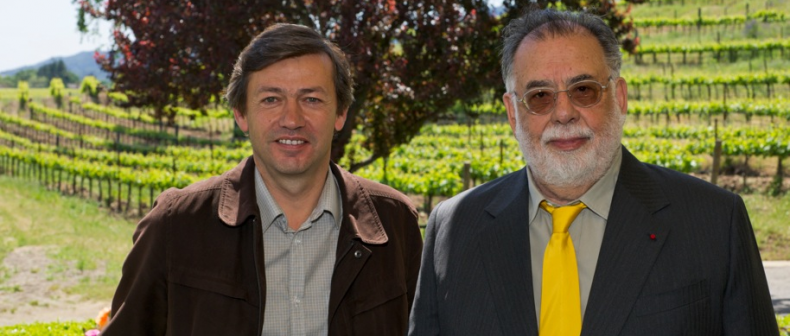
This is part one of our story on Francis Ford Coppola’s Inglenook Vineyard. Part two will run next Thursday.
It’d be easy to write off a famous film director’s Napa Valley winery as yet another vanity project in a region full of ostentatious, lifestyle wineries. But Coppola’s story is a little different. Like Apocalypse Now, Inglenook Vineyard took a painfully long time to create, fraught with unexpected challenges and commercial intrigue. The beautiful Napa estate was made, then un-made, then made whole again in a story with as many twists and turns as a clever Hollywood screenplay. Three men from three generations are responsible for the Inglenook story that now spans 130 years: Gustave Niebaum (formerly Gustav Nybom), John Daniel Jr., and now Francis Ford Coppola, the current generation and the man who has written the latest, but certainly not final chapters of the epic Inglenook story.
The history of Inglenook stretches almost as far back as the first full-time settlement in Napa Valley. George C. Yount, after whom Yountville was posthumously named in 1867, received a large land grant in exchange for various services rendered to General Vallejo, and he settled and planted the first grapes in the Napa Valley in 1838. Yount would eventually divide up his estate, offering land to his sister, Elizabeth Ann, near present-day Rutherford. She married Scotsman William Campbell Watson and established a winery in the area they named Inglenook, meaning “cozy corner” in Scottish dialect.
The Gustav Nybom (Niebaum) Era (Pictured)
The next character in the story is a Finnish sailor named Gustav Nybom, born in Helsinki in 1842. After earning his masters papers from the Nautical Institute in 1864, Nybom was offered his first command on a ship sailing through the Bearing Sea to Alaska, then part of the Russian Empire. Nybom quickly became Consul of Russia to the United States and spent three years exploring and mapping the frozen tundra and shorelines of the region. A man of foresight and ambition, Nybom developed a side business with local trappers bartering sealskins and furs, which would eventually earn him millions. During its first twenty years, the Alaska Commercial Company, as Nybom named his side venture, generated over $9.7-million in lease payments from the U.S. Government, almost three times more than what Russia had sold Alaska to the US for in 1867.
Nybom also ran parallel businesses including Alaska Packers, the first commercial salmon canning plant, the Northern Commercial Company which established 100 trading posts, as well as the Northern Navigation and Alaska Coast Companies that established shipping lines for the Alaskan Territories. Within ten years of setting sail from Finland Nybom had become one of the wealthiest men on the west coast of North America. But his wealth extended to knowledge, too: Nybom spoke five languages and had acquired a deep appreciation for fine European wine.
In 1873, after changing his name to Gustave Niebaum, he married an American, Susan Shingleberger. To fulfill his love of wine, he dreamed of buying a great Bordeaux Chteau. His wife, however, had other thoughts, and insisted they remain in America. Yet the dream to make fine wine would not die. Undaunted by the lack of established fine wine production and culture in the United States, Niebaum applied his ambition and single-mindedness to prospect for a place to make fine wine on the west coast. His research eventually led him to the Napa Valley, and to Rutherford in particular, the mid-way point between the fog-cooled southern end of the valley (now Carneros) and the hot and parched northern end of the valley. He favoured the benchlands above the valley floor, which would later be celebrated as the “Rutherford Bench”, now considered one of the top spots in the Napa Valley today.
Niebaum purchased the Inglenook estate in 1880, and set about the costly business of making fine wine. At the time he had few winemaking neighbors; Charles Krug had established a winery in 1861, and the Beringer brothers had set up their winery shortly before in 1876, but the Napa Valley had yet to be truly discovered as a source of great wine. But Niebaum’s tireless efforts and great fortune would soon help establish the Valley’s reputation.
In the Sunday morning edition of the San Francisco Examiner of April 6, 1890, a full-page article on Captain Gustave Niebaum and Inglenook appeared. The journalist begins by quoting Niebaum: “To produce the finest wines, to equal and excel the most famous vintages of Europe, it is necessary to have the right kind of vines, grown on suitable soils, well-manured, the most perfect cleanliness in handling, constant care and proper age.” These are the rules laid down by Captain Gustave Niebaum for making wines that will compel the admiration of experts.”
The article continues, outlining in amazing detail Niebaum’s philosophy for making fine wine. He was indeed a man ahead of his time, with an approach to making wine that could well be pulled directly from the marketing material of a 21st century winery. He continues in the interview: “Grow the right kind of grapes on suitable soil, pick it when it is fully ripe, see that it is handled with scrupulous cleanliness and properly fermented, and you will have an article that has no need of the cellar master, who is a functionary that has no place in an honest vineyard save to determine in what proportion different wines should be blended.”
Among many other innovative concepts for the era, the article reveals how Niebaum was among the first to plant high density vineyards (“Instead of a distance of seven or eight feet between the vines Captain Niebaum allows only 3 feet 6 inches”), picked at full ripeness even if it meant risking autumn rains (“more than once the crop had been lost because the rain came before the grapes were picked”), sold only estate bottled wines, protected by a tamper proof wire cage and the seal of the proprietor (“The Inglenook wines are offered to the public in glass only..”). All of this sounds standard to a 21st C sommelier, but was far from common practice over a century ago.
Niebaum’s devotion to quality paid off. By the time he died in August 5 1908, Inglenook was considered one of America’s finest wine estates. But the next several decades saw ups and downs. The winery closed for three years after the Captain’s death, but was re-opened in 1911 with his widow entrusting production and marketing to B. Arnold & Co. of San Francisco. Inglenook resumed its success almost immediately, collecting more medals at the 1915 Panama Pacific International Exposition than any other California winery. During prohibition from 1919 – 1933, Inglenook grapes were sold to Beaulieu vineyards for the production of sacramental wine, but the estate survived intact. Susan, Niebaum’s widow, died in 1936, leaving Inglenook to her great niece and nephew, Suzanne and John Daniel Jr., who had been raised on the Inglenook property since childhood.
To be continued…
—–
John Szabo is a master sommelier and wine writer for Toronto Standard. Follow his tweets here: @johnszabo.
More recommendations by John Szabo at www.johnswines.com
For more, follow us on Twitter @TorontoStandard and subscribe to our newsletter.














